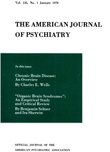DIFFERENTIATION BETWEEN ANXIETY AND DEPRESSION BY THE PHOTICALLY ACTIVATED ELECTROENCEPHALOGRAM
Abstract
1. To determine whether the EEG response to intermittent photic stimulation was quantitatively different in different emotional states, 134 psychiatric patients and 20 control subjects were studied. The amount of photic driving at flash rates of 10 and 15 per sec. was measured and the 15:10 response ratio determined.
2. There were significant differences in driving response between the sexes, females showing a greater response at all frequencies.
3. Response ratios were significantly higher in anxiety states than in depressions, with control subjects and paranoid schizophrenics intermediate.
4. Serial studies in a control subject showed that the driving response was labile and fluctuated in relation to feeling state. The direction of these fluctuations was as expected from the group differences demonstrated between anxiety and depression.
5. Results supported the hypothesis that the photically activated EEG is quantitatively different in different emotional states and that further research along present lines is indicated.
Access content
To read the fulltext, please use one of the options below to sign in or purchase access.- Personal login
- Institutional Login
- Sign in via OpenAthens
- Register for access
-
Please login/register if you wish to pair your device and check access availability.
Not a subscriber?
PsychiatryOnline subscription options offer access to the DSM-5 library, books, journals, CME, and patient resources. This all-in-one virtual library provides psychiatrists and mental health professionals with key resources for diagnosis, treatment, research, and professional development.
Need more help? PsychiatryOnline Customer Service may be reached by emailing [email protected] or by calling 800-368-5777 (in the U.S.) or 703-907-7322 (outside the U.S.).



